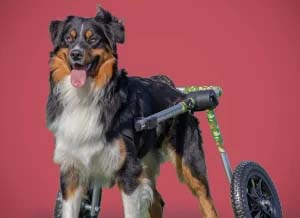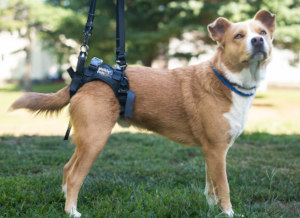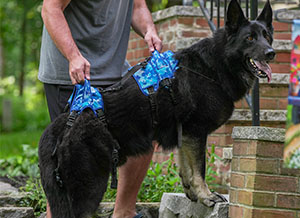- August 30, 2023
Supporting Your Dog When Their Back Legs Give Out
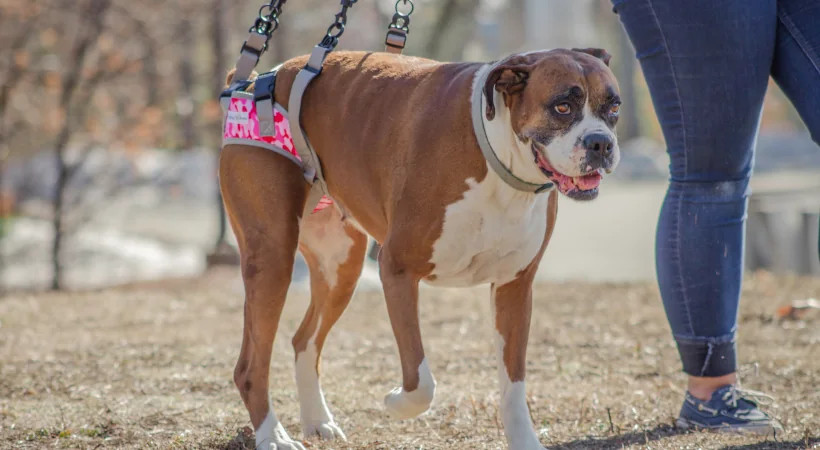
There are many reasons why a dog experiences hind leg weakness. Whether due to old age or a mobility condition, life becomes more complicated when a dog loses strength in its back legs. Many dogs with weak back legs struggle when getting up, have difficulty jumping, and some even struggle to walk.
As a pet parent, you need to pay attention to signs of change in your dog’s mobility, and understanding why your dog’s legs are losing strength can help you determine the best way to help your dog.
Signs Your Dog is Losing Strength in Their Back Legs
The signs that your dog’s legs are weakening can start out slowly and worsen over a long period or appear seemingly overnight. Always take notice of any changes in your dog’s behavior, appearance, or movements. The slightest change may indicate a change in your dog’s health and mobility. Signs of back leg weakness include:
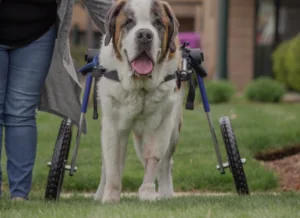
- Struggling to stand up after resting
- Change in gait or speed of walking
- Hind end swaying
- Sudden loss of balance
- Stumbling while walking
- Taking wobbly steps or instability
- Reluctance to play or go outside for a walk
- Inability to jump in or out of the car
- Struggling to climb stairs
- Loss of muscle mass (specifically in the hind end)
- Falling over or collapsing
At first, the symptoms may occur infrequently. Many dogs lose strength in their back legs slowly over an extended period of time. The changes in their mobility are barely noticeable at first. Many pet parents may chalk up their dog’s struggles as a natural slowing down from getting older, and it may be true, but if you notice any signs your dog is becoming weaker, speak to your veterinarian. There’s no reason to wait, and early treatment may even prevent leg weakness from progressing any further.
6 Common Causes of Hind Leg Weakness in Dogs
Hind leg weakness in dogs can be a natural part of the aging process. However, it can also be the first sign that your dog is experiencing mobility loss. The cause of your dog’s back leg weakness can be caused by an Inherited health issue like hip dysplasia or degenerative myelopathy, injury, arthritis, or a neural condition.
Here are some of the more common mobility conditions that cause weakness in a dog’s legs:
Old Age and Mobility Loss in Senior Dogs
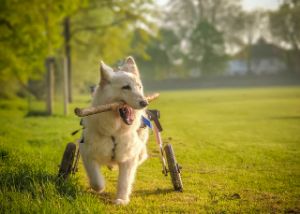
Senior dogs tend to “slow down” as they get older, but their slowing can often be attributed to arthritis or another underlying health condition. It’s pretty common for older dogs to have trouble getting up with their back legs.
We know that senior pets will sleep more and move less, but it’s important not to ignore the warning signs of mobility loss. Too often, pet parents say they waited too long to get their dog help and wish they had done something sooner. Mobility loss is often progressive and will worsen. The farther along a dog’s leg weakness has gone, the harder it is for it to rebuild its leg strength. To help an old dog with weak back legs, contact your veterinarian. Remember, even the oldest of dogs benefit from early intervention and treatment.
Canine Muscle Atrophy
The physical changes in your dog’s body caused by muscle atrophy are easy to spot. As dogs become less active, their muscles begin to atrophy. Dogs that are ill, dealing with joint pain, or struggling to walk will lose muscle mass faster than other dogs. Most dogs will show signs of atrophy in their hips and hind legs first, which may make their hind ends look shrunken. Ataxia, progressive limb weakness, hind leg crossing, and dragging feet are common in dogs experiencing muscle atrophy.
Leg Injury
Canine leg injuries like a cruciate tear, broken bone, or soft tissue injury can all impact how your dog moves as they recover and can even cause long-term damage depending on the nature of the injury. Dogs that are laid up with a long recovery from a traumatic leg injury or surgical recovery may be on extended crate rest as they heal. Being unable to walk or move regularly can weaken their back legs. Often, this leg weakness is only temporary, but it certainly impacts a dog’s physical and emotional well-being.
Your pet’s recovery plan will vary depending on the nature of the injury, but establish a plan with your veterinarian on how (and when) your dog can get back up on its feet safely.
Hip Dysplasia or Arthritis
Aching joints from arthritis or hip dysplasia can make every step a dog takes painful. Chronic joint and hip pain can discourage a dog from their daily activities, causing them to become lethargic and reluctant to stand or walk. Dogs need regular exercise to stay healthy, and it doesn’t take long for a “down dog” to lose both leg strength and muscle mass.
Degenerative Myelopathy
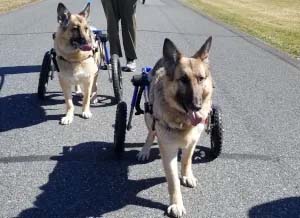
Dogs diagnosed with Degenerative Myelopathy experience progressive mobility loss. In its earliest stages, dogs with DM will experience hind leg weakness, dragging rear paws (also known as knuckling under), and can see significant muscle loss.
Degenerative Myelopathy can progress quickly, and dogs with DM will eventually become paralyzed. At some point, every DM dog will require a wheelchair for continued mobility and support. The best dog wheelchair for Degenerative Myelopathy is an adjustable wheelchair where the front wheels can be added later when needed.
IVDD
Intervertebral Disc Disease is a common cause of sudden mobility loss in dogs. Dogs with IVDD experience a sudden disc rupture or herniation that can impede the nerves in the spinal cord. Often, a dog experiencing a herniated disc from IVDD will yelp and then be unable to walk. A dog’s paralysis may be temporary or permanent, depending on the severity of the slipped disc and how fast they receive treatment. Many IVDD dogs will require crate rest, back support, a dog wheelchair, or even surgery to correct their disc issue.
How to Help Your Dog When Their Back Legs Give Out
As a pet parent, there is nothing worse than watching your best friend struggle to stand and walk on their own. If your dog cannot support itself on their hind legs or has their back legs collapse under them, they need mobility support. Luckily, there are simple solutions available to help you support your dog when its back legs give out. Here are a few ways you can help support a dog with weak back legs:
Rear Lifting Harness for Dogs with Hind Leg Weakness
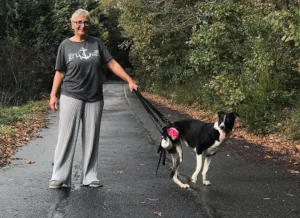
The first thing every pet parent needs to buy for a dog with hind leg weakness is a rear harness. Even dogs who only experience occasional weakness in their back legs will benefit from a rear lifting harness.
A rear harness is simple to use; most are designed to slide up a dog’s back legs and attach over its hind end, with handles to allow you to support your dog from underneath. For dogs whose hind legs will become weaker or need a long-term mobility solution, choose a rear support harness that attaches to a dog’s wheelchair for continued mobility.
Dog Wheelchairs for Weak Back Legs
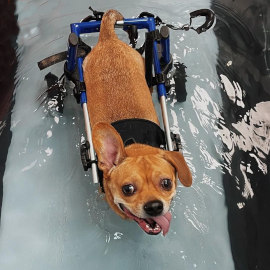
Contrary to popular belief, dog wheelchairs aren’t only for paralyzed dogs. Dog wheelchairs support the back legs to provide stability and make it easier for dogs to walk, run, and play, while still using all four legs.
As a dog’s back legs weaken, simple activities like enjoying a daily walk or going outside to pee and poop can become tiring. As dogs lose strength in their back legs, they may sway, stumble, struggle to walk, and tire quickly. A dog wheelchair can give your dog the support they need to maintain their independence, walk confidently, and eliminate the fear that they may suddenly lose their balance or fall.
Mobility carts for dogs can even be used for short-term rehabilitation in pets, rebuilding their strength while recovering from surgery or healing from an injury. For example, dog wheelchairs relieve and reduce the pressure placed on aching leg joints to allow a dog to slowly build up their leg strength while staying active.
Building Leg Strength Through Canine Rehabilitation
Recovery from back leg weakness may be possible, but this greatly depends on what’s causing the loss of leg strength. For example, dogs who have experienced atrophy and muscle loss caused by injury or surgical recovery stand a good chance of regaining strength in their back legs.
However, dogs whose legs are weak due to a degenerative condition or other mobility conditions may never regain full use of their back legs. Nevertheless, all animals, regardless of diagnosis, benefit significantly from canine rehabilitation. Rehab therapy comprises structured exercises, stretching, and therapeutic treatments that help dogs strengthen their muscles, build strength, and even help prevent or at least slow down atrophy.
Many rehab specialists use hydrotherapy and underwater treadmills to help dogs strengthen their back legs. The water’s resistance and buoyancy help ease the pain in aching leg joints and make it easier for a dog to stay active. And since most dogs love water, they have fun at the same time!
Canine Hip Support for Pets with Bad Hips
Surgery isn’t the only option for a pet dealing with hip dysplasia or hip pain. Hip dysplasia can be painful and make every step excruciating. A dog hip brace relieves joint pain and helps to secure the hip joint to prevent further injury. A dog hip brace applies pressure and compression over the hip joint to relieve hip pain and creates a sense of “lift” to the leg, which encourages a dog to walk. Continued mobility is key to a dog’s rehabilitation; combining hip support with low-impact exercises helps to strengthen leg muscles and the surrounding tissue to help dogs reach a point where they may no longer need hip support to stand or walk on their own.
Related Articles:
Did we answer all your questions on “Leg Weakness”?
Tags
What do you think?
Related Articles

New Puppy Checklist: Gear You’ll Need for Your New Dog
Getting a new puppy is really exciting, but before you welcome them home, it’s important to prepare your space for them. Since puppies need a

How Big Do Mini Poodles Get? Vet Reviewed Average Weight & Growth Chart – Dogster
The information is current and up-to-date in accordance with the latest veterinarian research. Learn more » When you buy a Miniature Poodle, you might not

Can Police Dogs Smell Nicotine? Vet Verified Facts & Info – Dogster
The information is current and up-to-date in accordance with the latest veterinarian research. Learn more » While cigarette sales have been declining steadily for decades,

How Old Is 5 in Dog Years? Vet-Approved Guide to Each Size of Dog – Dogster
The information is current and up-to-date in accordance with the latest veterinarian research. Learn more » A common method for calculating a dog’s age is


